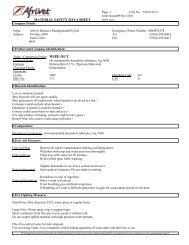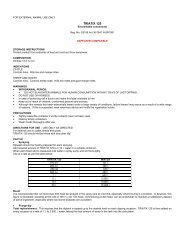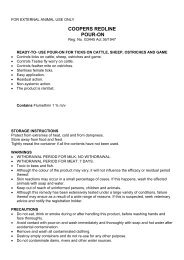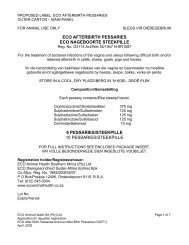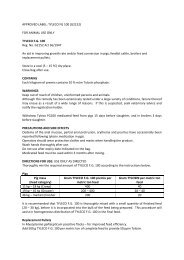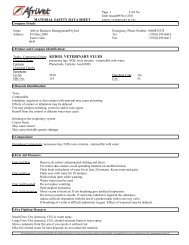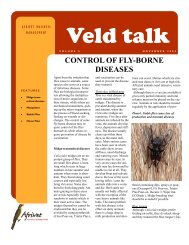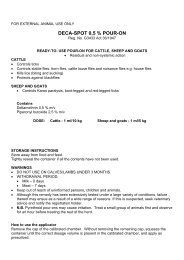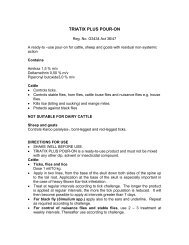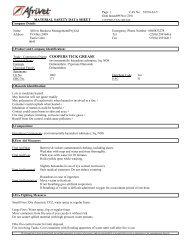Tick borne diseases and their control.pdf - Afrivet
Tick borne diseases and their control.pdf - Afrivet
Tick borne diseases and their control.pdf - Afrivet
You also want an ePaper? Increase the reach of your titles
YUMPU automatically turns print PDFs into web optimized ePapers that Google loves.
PAGE 4<br />
occur. In practice it is difficult for a stable<br />
situation to be achieved in marginal areas of<br />
B. bigemina (western border of the distribution).<br />
In addition researchers have found that<br />
enzootic stability has never been achieved in<br />
B. bovis areas in SA because of the low<br />
prevalence of the organism in ticks. Redwater<br />
outbreaks can occur when there is a massive<br />
tick challenge for example when cattle<br />
are placed in new camps with huge tick<br />
populations. Vaccination is safest when<br />
done between 3-6 months, when treatment<br />
is seldom necessary. Adult animals that require<br />
vaccination must be strictly supervised<br />
as they may require treatment.<br />
ANAPLASMOSIS<br />
Anaplasmosis is the most widespread of all the<br />
tick <strong>borne</strong> <strong>diseases</strong> because it is transmitted by 5<br />
different ticks. Under feedlot <strong>and</strong> dairy conditions<br />
the organism can be transmitted by stable<br />
flies. Anaplasmosis outbreaks occur in summer<br />
in adult animals; those under 6 months are usually<br />
immune. Outbreaks can occur in the winter<br />
months if tick numbers are high.<br />
The disease has a long incubation period of 4-6<br />
weeks: affected animals are weak <strong>and</strong> listless<br />
due to a progressive anaemia. They develop constipation<br />
because the rumen function becomes<br />
impaired. The animals may develop jaundice,<br />
show reduced weight <strong>and</strong> may abort. Death can<br />
result if the animals are not treated.<br />
The diagnosis of anaplasmosis is confirmed by finding of the organisms<br />
in a blood smear. Treatment with oxytetracycline (ECOmycin<br />
LA, ECOmycin Dual Purpose, Econotet 125)or imidocarb (Forray<br />
65, Imizol) is effective. None of the remedies sterilize the infection.<br />
The management of anaplasmosis<br />
• Intensive tick <strong>and</strong> fly <strong>control</strong>: this should be done in dairies<br />
where the stress of milk production causes cases. No vaccination<br />
is necessary.<br />
• Strategic tick <strong>control</strong> with vaccination: this is achieved with low<br />
intensity dipping <strong>and</strong> vaccination of young animals to ensure<br />
immunity. Sporadic outbreaks can still occur in marginal areas<br />
or after dry periods. Vaccination is done between 3-9 months<br />
when calves don’t react severely. Anaplasmosis vaccination can<br />
be done simultaneously with redwater vaccination<br />
TICK TOXICOSIS<br />
Apart from the component in the saliva of the tickwhich causes a decrease<br />
in appetite <strong>and</strong> reduction in weight gain, there are some ticks<br />
that have specific toxins:<br />
Sweating sickness: this is caused by the bont-legged tick (Hyalomma<br />
truncatum). Affected calves show a wet dermatitis due to the leakage<br />
of serum from the skin, which gives the impression of the calf sweating.<br />
To reverse the condition, the ticks which are often found on the<br />
tip of the tail, must be removed. The animals should be given a dose<br />
of antibiotics, as the toxin suppresses the immune system <strong>and</strong> can<br />
give rise to secondary infections such as pneumonia. Sick animals<br />
must be fed soft food <strong>and</strong> kept in the shade during the recovery<br />
phase.<br />
Photo 6. The Anaplasma organism in a red blood cell <strong>and</strong> one of<br />
the 5 tick vectors (Schering Plough Animal Health)<br />
VELD TALK



